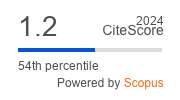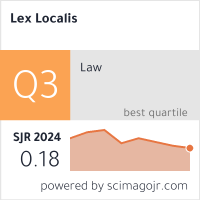Determinants of E-government Technology Adoption for Government Employees in China: Based on the UTAUT3 Model
DOI:
https://doi.org/10.4335/21.4.1043-1066(2023)Keywords:
UTAUT3 model, e-government, government employees, technology adoption, PLS-SEMAbstract
E-government technology (EGT) is the cornerstone of efficient government offices, which can streamline their work to enhance service quality for government employees. Thus, it is essential to examine the determinants of EGT implementation by government employees. Guided by the Unified Theory of Acceptance and Use of Technology 3 model, this research explores critical determinants that affect EGT adoption. Results from questionnaires completed by 207 Chinese government employees indicated that EGT adoption intention is positively affected by facilitating conditions (FC), habit (HB) and personal innovativeness (PI). Moreover, it partially mediates the relationship between HB and EGT adoption behavior, as well as PI and EGT adoption behavior. EGT adoption behavior is significantly affected by HB and PI. Surprisingly, research found other factors not significant for EGT adoption intention. This research contributes to the theory in the area of e-government and provides valuable insights for government agencies, with theoretical and practical significance.
References
Ain, N., Kaur, K. & Waheed, M. (2016) The influence of learning value on learning management system use: An extension of UTAUT2, Information Development, 32(5), pp. 1306-1321, https://doi.org/10.1177/0266666915597546.
Al-Refaie, A. & Ramadna, A. M. (2017) Barriers to E-Government Adoption in Jordanian Organizations from Users’ and Employees’ Perspectives, International Journal of Electronic Government Research, 13(1), pp. 33-51, https://doi.org/10.4018/ijegr.2017010103.
Alalwan, A. A., Dwivedi, Y. K., Rana, N. P., Lal, B. & Williams, M. D. (2015) Consumer adoption of Internet banking in Jordan: Examining the role of hedonic motivation, habit, self-efficacy and trust, Journal of Financial Services Marketing, 20(2), pp. 145-157.
Awwad, M. S. & Al-Majali, S. M. (2015) Electronic library services acceptance and use An empirical validation of unified theory of acceptance and use of technology, Electronic Library, 33(6), pp. 1100-1120, https://doi.org/10.1108/el-03-2014-0057.
Bhattacherjee, A. (2000) Acceptance of e-commerce services: The case of electronic brokerages, IEEE Transactions on Systems Man and Cybernetics Part a-Systems and Humans, 30(4), pp. 411-420, https://doi.org/10.1109/3468.852435.
Brown, M. M. & Brudney, J. L. (2001) Achieving advanced electronic government services: An examination of obstacles and implications from an international perspective, National Public Management Research Conference, Bloomington, 2, pp. 143-49.
Brown, S. A. & Venkatesh, V. (2005) Model of adoption of technology in households: A baseline model test and extension incorporating household life cycle, MIS Quarterly, 29(3), pp. 399-426.
Chuang, Y. F. (2011) Pull-and-suck effects in Taiwan mobile phone subscribers switching intentions, Telecommunications Policy, 35(2), pp. 128-140, https://doi.org/10.1016/j.telpol.2010.12.003.
Coulter, K. S. & Coulter, R. A. (2007). Distortion of price discount perceptions: The right digit effect, Journal of Consumer Research, 34(2), pp. 162-173, https://doi.org/10.1086/518526.
Davis, F. D. (1989) Perceived Usefulness, Perceived Ease of Use, and User Acceptance of Information Technology, MIS Quarterly, 13(3), pp. 319-340.
Dhiman, N., Arora, N., Dogra, N. & Gupta, A. (2020) Consumer adoption of smartphone fitness apps: an extended UTAUT2 perspective, Journal of Indian Business Research, 12(3), pp. 363-388, https://doi.org/10.1108/jibr-05-2018-0158.
Farooq, M. S., Salam, M., Jaafar, N., Fayolle, A., Ayupp, K., Radovic-Markovic, M. & Sajid, A. (2017) Acceptance and use of lecture capture system (LCS) in executive business studies Extending UTAUT2, Interactive Technology and Smart Education, 14(4), pp. 329-348, https://doi.org/10.1108/itse-06-2016-0015.
Gholami, R., Singh, N., Agrawal, P., Espinosa, K. & Bamufleh, D. (2021) Information Technology/Systems Adoption in the Public Sector: Evidence From the Illinois Department of Transportation, Journal of Global Information Management, 29(4), pp. 172-194, https://doi.org/10.4018/JGIM.20210701.oa8.
Gunasinghe, A., Abd Hamid, J., Khatibi, A. & Azam, S. M. F. (2019) The adequacy of UTAUT-3 in interpreting academician’s adoption to e-Learning in higher education environments, Interactive Technology and Smart Education, 17(1), pp. 86-106, https://doi.org/10.1108/itse-05-2019-0020.
Gunasinghe, A., Abd Hamid, J., Khatibi, A. & Azam, S. M. F. (2020) The viability of UTAUT-3 in understanding the lecturer’s acceptance and use of virtual learning environments, International Journal of Technology Enhanced Learning, 12(4), pp. 458-481, https://doi.org/10.1504/ijtel.2020.110056.
Gupta, A., Dogra, N. & George, B. (2018) What determines tourist adoption of smartphone apps?: An analysis based on the UTAUT-2 framework, Journal of Hospitality and Tourism Technology, 9(1), pp. 48-62, https://doi.org/10.1108/jhtt-02-2017-0013.
Gupta, S., Mathur, N. & Narang, D. (2022) E-leadership and virtual communication adoption by educators: an UTAUT3 model perspective, Global Knowledge Memory and Communication, https://doi.org/10.1108/gkmc-01-2022-0001.
Hair, J. F., Ringle, C. M. & Sarstedt, M. (2011) PLS-SEM: Indeed a silver bullet, Journal of Marketing theory and Practice, 19(2), pp. 139-152.
Hair, J. F., Risher, J. J., Sarstedt, M. & Ringle, C. M. (2019) When to use and how to report the results of PLS-SEM, European Business Review, 31(1), pp. 2-24, https://doi.org/10.1108/ebr-11-2018-0203.
Hwang, Y. (2011) Predicting Attitudes Toward Knowledge Sharing by E-Mail: An Empirical Study, International Journal of Human-Computer Interaction, 27(12), pp. 1161-1176, https://doi.org/10.1080/10447318.2011.565706.
Iftakhar, S. (2016) Google classroom: what works and how, Journal of Education and Social Sciences, 3(1), pp. 12-18.
Jackson, J. D., Yi, M. Y. & Park, J. S. (2013) An empirical test of three mediation models for the relationship between personal innovativeness and user acceptance of technology, Information & Management, 50(4), pp. 154-161, https://doi.org/10.1016/j.im.2013.02.006.
Jaganathan, M., Mustapa, A. N., Hasan, W. A. W., Mat, N. K. N. & Alekam, J. M. E. (2014) Does dependency make a difference? The role of convenience, social influence, facilitating condition and self-efficacy on student’s purchase behaviour of smartphone, AIP Conference Proceedings, 1635(1), (American Institute of Physics), pp. 332-339.
Jongcheul, P. (2004) Designing system architecture for cadastral information dissemination using Internet (The Netherlands: International Institute for Geo-Information Science and Earth Observation Enschede), available at: https://webapps.itc.utwente.nl/librarywww/papers_2004/msc/gim/park_jongcheul.pdf (October 6, 2023).
Kelman, H. C. (1958) Compliance, identification, and internalization three processes of attitude change, Journal of conflict resolution, 2(1), pp. 51-60.
Koh, C. E., Prybutok, V. R., Ryan, S. D. & Wu, Y. A. (2010) A Model for Mandatory Use of Software Technologies: An Integrative Approach by Applying Multiple Levels of Abstraction of Informing Science, Informing Science: the International Journal of an Emerging Transdiscipline, 13, pp. 177-203, https://doi.org/10.28945/1326.
Lewis, C. C., Fretwell, C. E., Jim, R. & Parham, J. B. (2013) Faculty Use of Established and Emerging Technologies in Higher Education: A Unified Theory of Acceptance and Use of Technology Perspective, International Journal of Higher Education, 2(2), https://doi.org/10.5430/ijhe.v2n2p22.
Lewis, W., Agarwal, R. & Sambamurthy, V. (2003) Sources of influence on beliefs about information technology use: An empirical study of knowledge workers, MIS Quarterly, 27(4), pp. 657-678.
Liao, C. C., To, P. L., Liu, C. C., Kuo, P. Y. & Chuang, S. H. (2011) Factors influencing the intended use of web portals, Online Information Review, 35(2), pp. 237-254, https://doi.org/10.1108/14684521111128023.
Limayem, M., Hirt, S. G. & Cheung, C. M. K. (2007) How habit limits the predictive power of intention: The case of information systems continuance, Mis Quarterly, 31(4), pp. 705-737, https://doi.org/10.2307/25148817.
Meet, R. K., Kala, D. & Al-Adwan, A. S. (2022) Exploring factors affecting the adoption of MOOC in Generation Z using extended UTAUT2 model, Education and Information Technologies, 27(7), pp. 10261-10283, https://doi.org/10.1007/s10639-022-11052-1.
Mengesha, G. H., Garfield, M. J. & Assoc Informat, S. (2016) A Contextualized IT adoption and Use Model for e-health: The Case of Telemedicine at Black Lion Teaching Hospital, Ethiopia, Paper presented at the 22nd Americas Conference on Information Systems (AMCIS) (San Diego, CA).
Midgley, D. F. & Dowling, G. R. (1978) Innovativeness: The Concept and Its Measurement, Journal of Consumer Research, 4(4), pp. 229-242, https://doi.org/10.1086/208701.
Mtebe, J. S. & Raisamo, R. (2014) A Model for Assessing Learning Management System Success in Higher Education in Sub‐Saharan Countries, Electronic Journal of Information Systems in Developing Countries, 61(1), pp. 1-17.
Musa, M., Ismail, M. N., Tahir, S., Fudzee, M. F. M. & Jofri, M. H. (2022) Student Acceptance Towards Online Learning Management System based on UTAUT2 Model, International Journal of Advanced Computer Science and Applications, 13(11), pp. 139-147.
Panda, P. & Sahu, G. (2013) Critical Success Factors for e-Gov Project: A Unified Model, IUP Journal of Supply Chain Management, 10(2), pp. 19-32.
Rehouma, M. B. & Hofmann, S. (2018) Government employees’ adoption of information technology: a literature review, Proceedings of the 19th Annual International Conference on Digital Government Research: Governance in the Data Age, pp. 1-10.
Rogers, E. M. (1983) Diffusion of innovations (New York: The Free Press).
Saha, P. & Kiran, K. B. (2022) An Exploration of Trust as an Antecedent of Unified Payment Interface Usage: A SEM-Neural Network Approach, International Journal of Electronic Government Research, 18(1), https://doi.org/10.4018/ijegr.298627.
Sisman, A., Sesli, F. A. & Alkis, Z. (2009) E-government concept and e-government applications in Turkey, African Journal of Business Management, 3(11), pp. 644-653.
Subawa, N. S., Widhiasthini, N. W. & Mimaki, C. A. (2020) An empirical study of E-marketplace acceptance in MSMEs under the constructs of effort expectancy, social influence and facilitating condition factors, Proceedings of the 2020 The 6th International Conference on E-Business and Applications, pp. 116-120.
Suo, W. J., Goi, C. L., Goi, M. T. & Sim, A. K. S. (2022) Factors Influencing Behavioural Intention to Adopt the QR-Code Payment: Extending UTAUT2 Model, International Journal of Asian Business and Information Management, 13(2), https://doi.org/10.4018/IJABIM.20220701.oa8.
Tamilmani, K., Rana, N. P., Prakasam, N. & Dwivedi, Y. K. (2019) The battle of Brain vs. Heart: A literature review and meta-analysis of "hedonic motivation" use in UTAUT2, International Journal of Information Management, 46, pp. 222-235, https://doi.org/10.1016/j.ijinfomgt.2019.01.008.
Taylor, S. & Todd, P. A. (1995) Understanding information technology usage: A test of competing models, Information Systems Research, 6(2), pp. 144-176, https://doi.org/10.1287/isre.6.2.144.
Tiwari, M., Gupta, Y., Khan, F. M. & Adlakha, A. (2022) UTAUT3 model viability among teachers due to technological dynamism during COVID-19, Information Discovery and Delivery, 50(3), pp. 245-259, https://doi.org/10.1108/idd-02-2021-0018.
Tseng, T. H., Lin, S. J., Wang, Y. S. & Liu, H. X. (2022) Investigating teachers? adoption of MOOCs: the perspective of UTAUT2, Interactive Learning Environments, 30(4), pp. 635-650, https://doi.org/10.1080/10494820.2019.1674888.
Venkatesh, V. & Davis, F. D. (2000) A theoretical extension of the Technology Acceptance Model: Four longitudinal field studies, Management Science, 46(2), pp. 186-204, https://doi.org/10.1287/mnsc.46.2.186.11926.
Venkatesh, V., Morris, M. G., Davis, G. B. & Davis, F. D. (2003) User acceptance of information technology: Toward a unified view, MIS Quarterly, 27(3), pp. 425-478, https://doi.org/10.2307/30036540.
Venkatesh, V., Thong, J. Y. L. & Xu, X. (2012) Consumer acceptance and use of information technology: extending the unified theory of acceptance and use of technology, MIS Quarterly, 36(1), pp. 157-178.
Venkatraman, M. P. & Price, L. L. (1990) Differentiating between cognitive and sensory innovativeness: Concepts, measurement, and implications, Journal of Business Research, 20(4), pp. 293-315, https://doi.org/10.1016/0148-2963(90)90008-2.
Verplanken, B. & Aarts, H. (1999) Habit, Attitude, and Planned Behaviour: Is Habit an Empty Construct or an Interesting Case of Goal-directed Automaticity?, European Review of Social Psychology, 10(1), pp. 101-134.
Verplanken, B. & Wood, W. (2006) Interventions to break and create consumer habits, Journal of Public Policy & Marketing, 25(1), pp. 90-103, https://doi.org/10.1509/jppm.25.1.90.
Warshaw, P. R. (1980) A new model for predicting behavioral intentions: An alternative to Fishbein, Journal of Marketing Research, 17(2), pp. 153-172.
Williams, M. D., Rana, N. P. & Dwivedi, Y. K. (2015) The unified theory of acceptance and use of technology (UTAUT): a literature review, Journal of Enterprise Information Management, 28(3), pp. 443-488, https://doi.org/10.1108/jeim-09-2014-0088.
Yildiz, M. (2007) E-government research: Reviewing the literature, limitations, and ways forward, Government Information Quarterly, 24(3), pp. 646-665, https://doi.org/10.1016/j.giq.2007.01.002.








